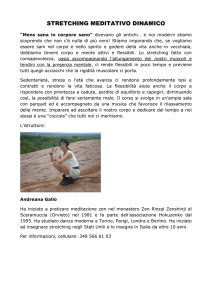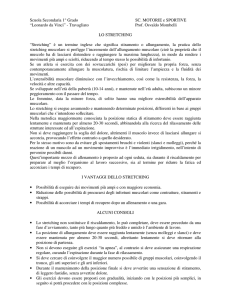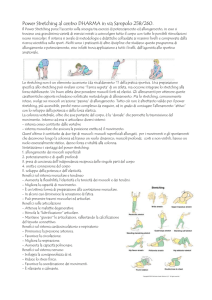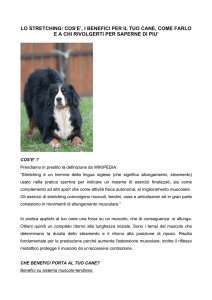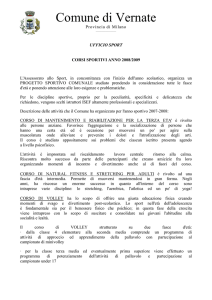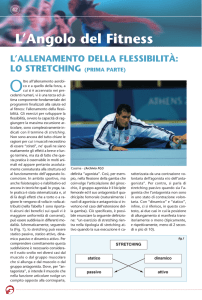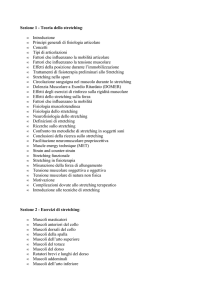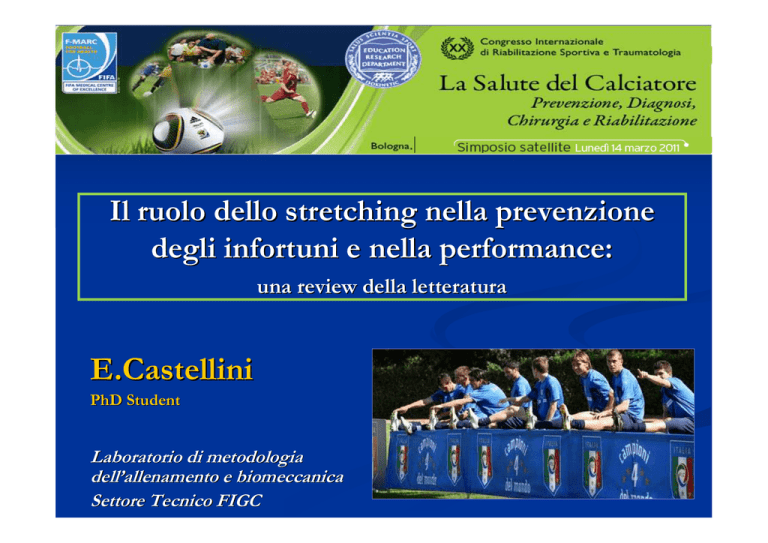
XX International International Conference on Sports Rehabilitation and Traumatology
Health for the Football Player – Prevention, Diagnosis, Surgery and Rehabilitation
12th-13th March, 2011 - BOLOGNA - Italy
Il ruolo dello stretching nella prevenzione
degli infortuni e nella performance:
una review della letteratura
E.Castellini
PhD Student
Laboratorio di metodologia
dell’allenamento e biomeccanica
Settore Tecnico FIGC
Athletics Culture
“Lo Stretching è ormai parte
integrante della cultura di
tutte le discipline sportive”
La letteratura
Prima della prestazione:
una seduta può incidere in maniera negativa
sull’espressione di forza muscolare.
Effetto combinato con altri esercizi durante il
riscaldamento
Prevenzione infortuni:
Evidenze che un attività di stretching svolta in
maniera regolare può prevenire gli infortuni
All’interno del riscaldamento – pochi studi e risultati
contrastanti
Quando viene fatto lo stretching?
Durante il riscaldamento
(allenamento e/o pre-partita):
finalità = PRESTATIVE
Lontano dalle sedute di
allenamento:
finalità = PREVENTIVE
Il ruolo dello stretching nel
riscaldamento
1. Garantire una buona
escursione articolare
2. Aumentare la flessibilità
3. Ridurre la “rigidità
muscolare”
(Halbertsma JPK et al, 1996, Witvrouw E et al. 2003)
Tecniche di Stretching
Balistico
PN F
Statico
Attivo
Passivo
Dinamico
Crach
Dinamico/Balistico
PNF - Crach
Statico
Effetti fisiologici dello stretching
Effetti
a breve termine
Viscoelastico
Nervoso
Effetti
a lungo termine
Effetto viscoelastico
Breve termine
Riduzione della resistenza
passiva all’allungamento
Statico:
2min = nessun effetto, (DePino et al
2000 Ryan et al. 2008a)
4 min = riduzione del 14% in 10
min (< 50%) (Ryan et al. 2008a);
6/8 min = riduzione del 18-20%
(Magnusson SP ,. 1995, 1996a; Ryan et al.
2008a);
PNF (hold-relax-swing technique) 6
minuti (S. Spernoga et al, . 2001)
Effetto nervoso
• Lo stretching ha un effetto INIBITORIO (Halbertsma JPK et
al, 1996) che sembra essere la causa principale della ridotta
capacità di produzione di forza
Questo effetto può essere:
1. anche del 20% (Avela et al., 1999) nella capacità di produrre forza
2. limitato nella capacità di produrre potenza nel salto verticale
(3-4% - Behm & Kibele, 2007) o la capacità di effettuare sprint (0-2% Winchester et al., 2008).
La perdita di forza dipende:
1. Tecniche di stretching utilizzate (es. dopo una
sessione di stretching dinamico, la perdita di forza è ridotta o
nulla (Herda et al., 2008; Hough et al., 2009).
2. Dal tipo di contrazione che utilizziamo
per misurare il calo della forza (isometrica,
isocinetica, isotonica)
3. Dal muscolo in cui viene misurata la forza
La perdita di forza
Fattore
nervoso:
Diminuzione
dell’ampiezza del segnale EMG
durante una MCV (Avela et al, 1999,2004)
Sul
muscolo controlaterale non allungato
(Cramer et al, 2005)
Effetto viscoelastico
Lungo termine
Cambiamenti strutturali con aumento
della compliance tendinea dovuta ad
una ridistribuzione di liquidi e
polisaccaridi all’interno delle matrici
collagene (Kubo et al 2002; McNair PJ et al. 2002, Witvrouw
E et al. 2004)
Kubo et al J. Appl. Physiol 2002
Aumento di flessibilità dopo un lungo programma con un
effetto che può durare per diverse settimane (McCue et al 1953; Zebas et al
, 1985)
Su N° 23 articoli (CTR) solo 1
suggerisce che lo stretching ha effetti
positivi
Su N° 4 articoli su sprinter :
N° 1 effetti positivi
N° 1 effetti negativi
N° 2 risultati equivoci
Su N° 9 studi su effetti dello stretching
svolto in maniera regolare:
N° 7 effetti positivi
N° 2 nessun effetto
Limiti degli studi
E
nel
calcio?
(considerazioni)
Spesso si valuta la perdita di forza/potenza e non il calo
delle caratteristiche legate alla prestazione sport-specifica
Lo stretching non viene mai isolato, ma sempre
integrato ad altre esercitazioni (warm-up).
Lo stress psicologico prima di un evento sportivo
probabilmente altera gli ingressi inibitori o eccitatori dei
muscoli in una misura che NON PUO’ ESSERE
REPLICATA IN LABORATORIO.
1 - An investigation into the effects of different warm-up
modalities on specific motor skills related to soccer
performance.
Fletcher IM, Monte-Colombo MM. 2010
J Strength Cond Res. 2010 Aug;24(8):2096-101.
27 male soccer player
3 warm-up conditions
Active warm-up (WU)
WU + static stretching (SPS)
WU + dynamic stretching (ADS)
HR, CMJ, 20-m Sprint, Balsom agility Test
Results:
CMJ significantly greater (p<0.01) in the WU and ADS
20-m sprint, Balsom agility Test, significantly slower (p<0.01) in the SPS
HR significantly greater (p<0.01) in the WU and ADS
2 - Effect of differential stretching protocols during warm-ups
on High Speed-Motor capacities in Professional Soccer
Players
T Little, A G Williams, 2006
J Strength Cond Res 2006, 20 (1), 203 -207
18 Professional soccer player
3 conditions
No stretch
Static stretch
Dynamic stretch
CMJ, stationary 10-m sprint, flying 20m sprint, agility
*
Results:
3 - Acute effects of different warm-up methods on sprint,
slalom dribling, and penalty kick performance in Soccer
Players
E Gelen, 2010
J Strength Cond Res 24 (4): 950-6 2010
26 male professional soccer player
4 warm-up conditions
A. 5’ jogging
B. 5’ jogging + Static Stretch
C. 5’ jogging + Dynamic Exercise
D. B + C (Static Stretch + Dynamic Exercise)
Sprint, slalom dribling, and penalty kick
performance
The result of this study suggest that it may desiderable for soccer
players to perform DYNAMIC EXERCISES (P<0.05) before the
performance of activities that require a high power output
4 - Acute effect of different Stretching methods on
Illinois Test in Soccer Player
M Amiri-Khorasani et al, 2010
J Strength Cond Res 2010 24 (10): 2698-704
Examine the effects of static, dynamic, and the combination of
static and dynamic stretching within a pre-exercise warm-up on the
Illinois Agility Test (IAT) in soccer players.
Illinois Agility Test
Dynamic stretching during the
warm-up was most effective as
preparation for agility
performance
5 - The acute effect of different warm-up protocols on
anaerobic performance in elite youth soccer players.
Needham RA et all, 2009
J Strength Cond Res. 2009 Dec;23(9):2614-20.
The results of the study
suggest that a dynamic
warm-up with the
inclusion of resistance
enhances jumping
ability more than dynamic
exercise alone.
In addition, a dynamic
warm-up produces a
superior sprint and jump
performance compared to
a warm-up consisting of
static stretching
20 elite youth soccer players
warm-up protocol 5-minute low-intensity jog
+ Static Stretching (SS),
+ Dynamic Stretching (DS)
+ Dynamic stretching followed by 8 front squats
+ 20% body mass (DSR).
CMJ, 10- and 20-m sprint test immediately and at 3
and 6 minutes after each warm-up protocol.
Results:
a statistically significant difference CMJ and 10- and
20-m sprint (p<0.05), between (DSR) and (SS)
6 - Effects of Static Stretching in warm-up on Repeated
Sprint Performance (RSA)
Sim AY et al, 2009
J Strength Cond Res 2009 23 (7): 2155-62
13 male soccer player
1000-m jog,
+ dynamic activities only (D)
+ static stretching followed by dynamic activities (S-D)
+ dynamic activities followed by static stretching (D-S)
RSA = 3 x (6 x 20m) – 25” recovery
The results suggest that 20-m repeated sprint ability may be
compromised when static stretching is conducted after
dynamic activities and immediately prior to performance
(D-S).
7 - The effect of Static Stretching on phases of
sprint performance in Elite soccer players
A L Sayers et al, 2008
J Strength Cond Res 22(5): 1416–1421, 2008
20 elite female soccer players
3 x 30-m sprints
Static stretching a 2-min rest
Results:
a statistically significant difference in
acceleration (p<0.01), maximal-velocity
sprint time (p< 0.01), and overall sprint time
(p< 0.01) between the stretch and no-stretch
conditions.
Static stretching before sprinting resulted in slower
times in all three performance variables
8 - Effects of Static Stretching on Repeated Sprint
(RSA) and Change of Direction (CODS) Performance
JR Beckett et al, 2009
Med Sci Sport Exerc. 2009 41(2): 444-50
12 male soccer player
Static stretching – a 4-min rest
RSA = 3 x 6 maximal sprint repetitions
CODS = 20 m with 4 cods (100°)
The result of this study suggest that an
ACUTE both (4 min) of Static Stretching of the
lower limbs during recovery pediods between
efforts may compromise RSA performance and
CODS (p<0.05)
Nel riscaldamento…..
Statico: non sembra avere una particolare utilità
Dinamico: inserito durante il warm-up risulta più
efficace come preparazione per le prestazioni di
agilità in giocatori di calcio senza influenzare
negativamente la prestazione di Forza e Agilità
Lo stretching previene gli infortuni?
Muscle flexibility as a Risk Factor for
Developing Muscle Injurier in Male
Professional Soccer Player
THE AMERICAN JOURNAL OF SPORTS MEDICINE
Witvrouw E et al. 2003
Fattori di Rischio per Infortuni Muscolari
Fattori Intrinsici
Genetica
Eta’ (Emery & Meeuwisse, 2001; Orchard, 2001; Verrall et al., 2001; Arnason et al., 2008)
Sesso
Recidive (Seward et al., 1993; Emery & Meeuwisse, 2001; Verrall et al., 2001; Arnason et al., 2008)
Squilibri muscolari tra agonista/antagonista e/o controlaterale (Orchard et al.,
1997; Tyler et al., 2001)
Flessibilita’ muscolare (Cross and Worrell 1999, Dvorak et al., 2000; Orchard, 2001;
Tyler et al., 2001; Verrall et al., 2001, Weldon et al 2003, Witvrouw E et al. 2003)
Fattori Estrinseci
Stretching
Riscaldamento
Errori di allenamento
Scarpe, superfici di gioco
Review
To stretch or not to stretch: the role of stretching in injury prevention
and performance
M. P. McHugh, C. H. Cosgrave, Scand J Med Sci Sports 2010
The Impact of Stretching on Sports Injury Risk: A Systematic
Review of the Literature
Thacker S. et al , Med Sci Sports Exerc. 2004.
Stretching and Injury Prevention: An Obscure Relationship
Witvrouw et al., Sports Med 2004
The efficacy of stretching for revention of exercise-related injury: a
systematic review of the literature
S.M. Weldon et al, Manual Therapy 2003
Stretching before exercise does not reduce the risk of local muscle
injury: a critical review of the clinical and basic science literature
Shrier I. Clin J Sport Med 1999;9:221–
1999;9:221–7.
Studi che esaminano gli effetti dello stretching sul
rischio di lesioni
Limiti degli studi
(considerazioni)
1.
Lo stretching non viene VALUTATO in maniera isolata
dalle altre attività;
2.
L’intervento dello stretching dovrebbe essere sufficiente
(per intensità, frequenza e durata) per poter incidere sulla
diminuzione della “rigidità muscolare”;
3.
I soggetti studiati non praticano sport ad alto impatto di
infortuni muscolari
“ The 11+" dura ca. 20 minuti e
sostituisce il consueto warm-up
prima dell'allenamento.
"Il 11 +" ha dimostrato di
ridurre le lesioni del 50% se
eseguito correttamente e
regolarmente (2/3 volte a
settimana).
“The 11+” è diviso in tre parti:
Parte I – esercizi di corsa
Parte II - esercizi di forza,
equilibrio, controllo muscolare e
stabilità di base
Parte III - esercizi con cambi di
direzione e balzi
In conclusione….
Le evidenze scientifiche che suggeriscono che lo
stretching, inserito nel riscaldamento, possa prevenire
gli infortuni non sono chiare (Thacker et al 2004, Witvrouw et al., 2004,
M. P. McHugh, et al 2010)
Esistono chiare evidenze scientifiche che un
riscaldamento specifico e adeguato alla prestazione ha
effetti positivi sulla prevenzione gli infortuni
muscolari (Safran MR, et al 1988, F-MARC FIFA 2010)
La scelta delle metodiche di stretching, come
ogni altro mezzo allenante, va sempre
contestualizzata in base:
ai tempi in cui l’effetto è atteso (acuto dopo una singola
applicazione, o cronico per applicazioni ripetute) e alle finalità che
si vogliono ottenere (miglioramento della postura, dell’elasticità,
recupero muscolare, ecc.),
al periodo della giornata (prima, dopo, o lontano
dall’allenamento),
allo stato muscolare (tonicità, retrazione, ecc.),
alla tipologia muscolare (agonista o antagonista nel gesto
atletico praticato, muscoli posturali, ecc.)
all’età e alla mentalità del giocatore.
In generale :
Nel riscaldamento, scegliere 4/5 esercizi di stretching dinamico
con intensità submassimale alternandoli con esercizi di mobilità
articolare
Nel defaticamento e per il recupero muscolare post-allenamento o
post-partita, utilizzare esercizi con intensità submassimale di breve
durata (es. posture)
Evitare impegnative sedute di stretching (PNF):
subito dopo il termine dell’allenamento molto intenso e /o partita
prima e/o dopo esercitazioni di forza intense (in particolare di forza esplosiva
per i gruppi muscolari impegnati in un lavoro prevalentemente eccentrico
In generale :
Eseguire sedute di stretching impegnative (Statico e PNF )
lontano dalla partita, quando sono previsti lavori a bassa intensità
nella fase di strutturazione dello schema corporeo (soprattutto per
i più giovani) è utile invece un approccio multilaterale (insegnare il
numero maggiore di tecniche possibile, rispettando la struttura
biologica e senza scadere nella monotonia).


